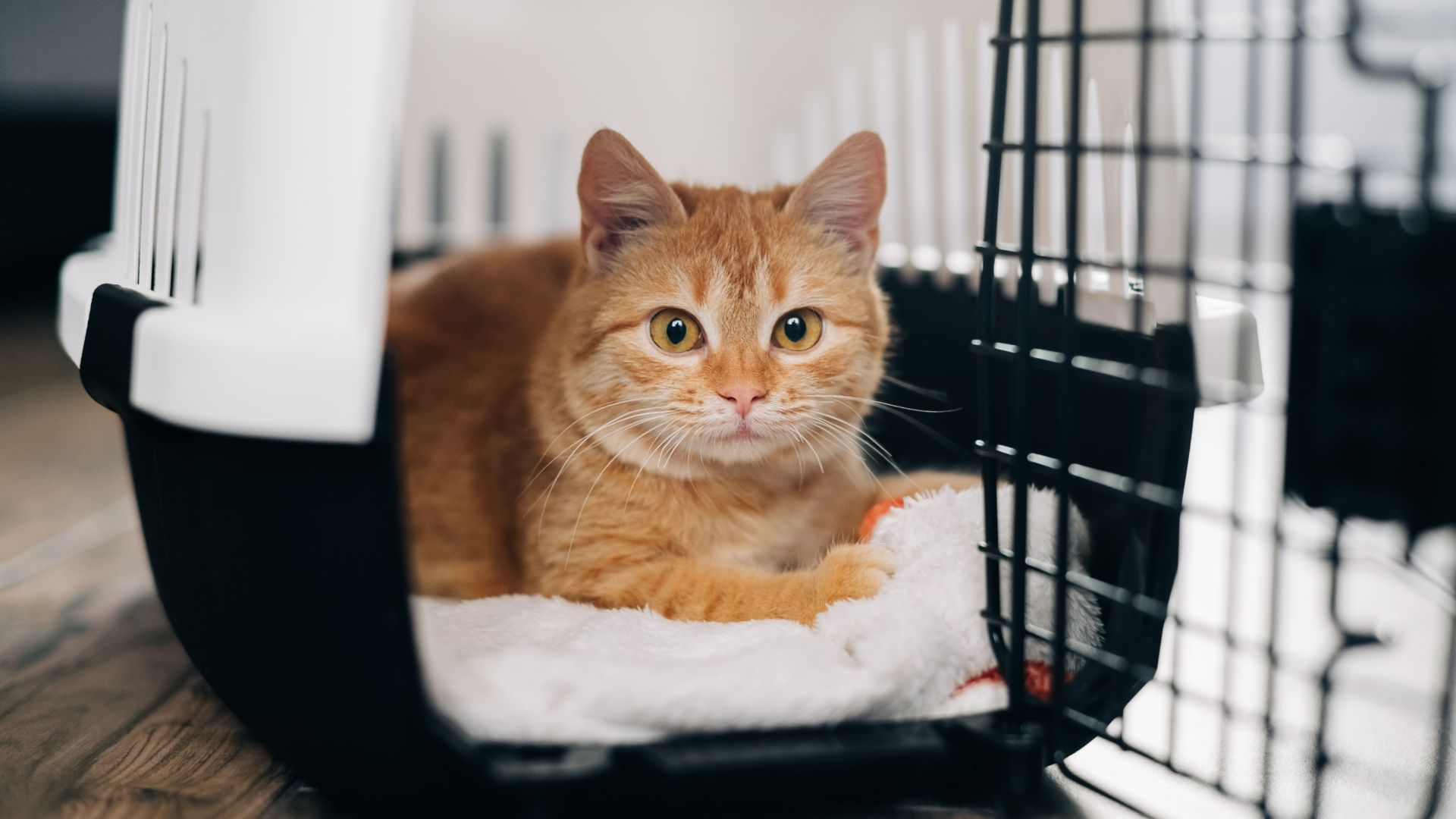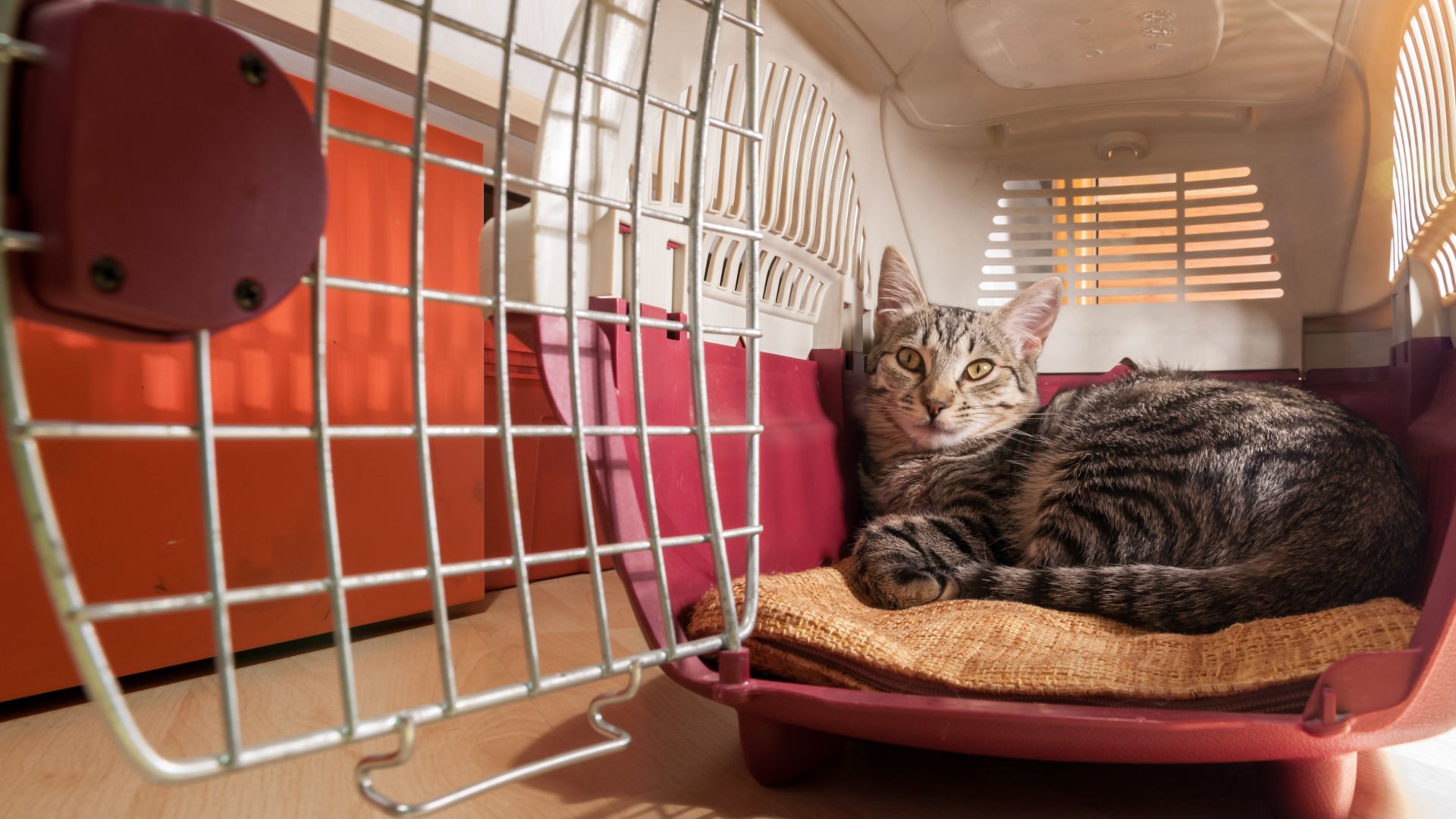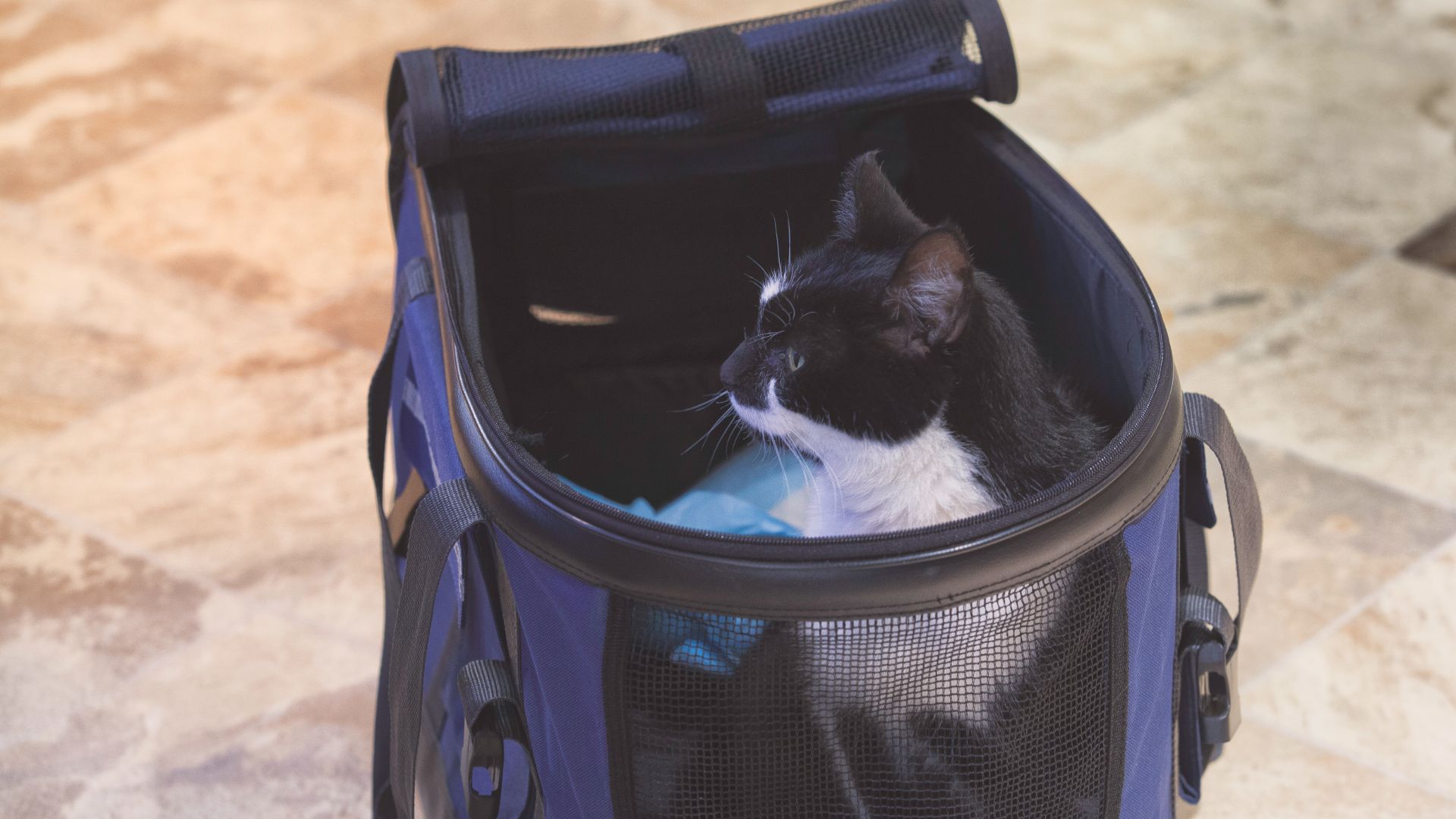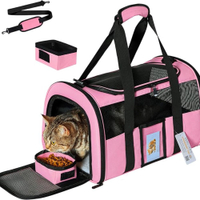How to get a cat into a carrier: 7 steps to success with tips from our vet
Learning how to get a cat into a carrier will be a piece of cake thanks to these stress-free steps that will ensure your kitty stays comfortable and content

Learning how to get a cat into a carrier quickly and easily is a great skill to master if you have a kitty who tends to scarper every time you want to take them on a road trip. While your cat may never come to love their carrier, there are definitely steps you can take to help lower their stress and anxiety levels and make the whole experience a more comfortable and pleasurable one for both them and you.
The first thing you want to do is to do some research and ensure you invest in one of the best cat carriers to help make traveling with a cat as easy as possible. The type you choose will be largely determined by whether you’re mainly wanting to use it for short trips or whether you have more long-haul adventures in mind. We recommend a carrier with plenty of ventilation that opens from both the front and top to help make getting your kitty in and out that much easier.
While the steps above will help make the whole process of transporting your cat from A to B a whole lot smoother, one of the most important tips we can offer is to ensure that you’re in a confident headspace before attempting to secure your kitty. This may sound silly, but believe it or not, the more confident and assured you feel and act, the more secure and less nervous your feline friend is likely to be.
How to get your cat to like their carrier
1. Get your kitty used to their carrier
According to companion animal vet Dr Rebecca MacMillan, the carrier is unfamiliar territory to most felines.
“What’s more, the carrier leads to somewhere that they may have a negative association with, like the vets or the cattery,” she adds.
“Some cats suffer from travel sickness and because the only time they go in a vehicle they are inside a carrier, they will again form a negative association with it. Carriers are also very confining so your cat is unable to stretch out or get a good view of the world while they are inside one. This can be unnerving for an animal that usually likes to keep an eye on their surroundings.
“Plus, the carrier may smell strange to your cat, especially if it has been stored in a shed or the loft.”
The key to successfully getting your cat into their carrier is to avoid only bringing the carrier out of the garage or spare room when you want to load your kitty in. Instead, give them lots of time to get used to it.
Dr Rebecca MacMillan adds: “The key to training your cat to be more accepting of the carrier is to always have it available in your house.
“If the door is open, and your cat’s favorite toys and treats are inside, they will often start to explore it at their leisure. This generally makes them much more accepting of the cat carrier and more likely to go into it for a vet visit.
“Feeding your cat their meals in the carrier in the run-up to an appointment can further build a positive association.”
Preparation is key here so we recommend you place the carrier in a prominent place within your home where you cat will see it for several weeks before you plan to use it. This will help familiarize your cat with the carrier and make it less threatening, so you won’t be struggling with how to get a stubborn cat into a carrier.
2. Make the carrier an inviting place to be
Next up is to make the carrier as homely a space as possible. You want it to feel like it’s an enjoyable place to be, so make it feel warm and inviting. “Leave the door off and put their favorite cat toys or treats in there so that your cat is free to explore it whenever they choose.,” says Dr MacMillan. “You may want to put a blanket or something that smells of your cat inside.”
If your carrier has a removable top half, now would be the time to take that off and just leave the base as this will encourage your kitty to wander in and out without the fear of being trapped. You can make this process more enticing for them by popping in one of the best cat beds and seeing if they’ll use their carrier as a sleep spot.
Don’t try to force your cat to sleep in their carrier, but do make it as relaxing and welcoming an environment as possible to see if this helps them to feel more at ease spending time in or around it.
“This all helps to build a positive association with the carrier, such that it feels like a safe space for them,” concludes Dr MacMillan. “Some cats may start using the carrier as a hiding place or bed.”
3. Place the carrier in a social area
One of the best ways to deepen the positive association your cat has with their carrier is to place it in an area where they spend a lot of time and feel the most comfortable and secure.
Whether it’s a bedroom or living area, choose a spot where your kitty often curls up for their nap or lazes about or a space that they visit frequently, like their scratching post. This will normalize the carrier and make it feel less threatening.
Petmate Two-Door Dog and Cat Kennel | Amazon
This crate is airline-approved with a two-door design for your pet’s ease and comfort. It’s easy to assemble and wipes
4. Provide treats
When it comes to getting your feline friend into their carrier, the best cat treats are going to be your secret weapon! You’d be amazed just how easy it can be to get your kitty to do something they’re not so keen on when there’s food involved, so we definitely recommend using treats to help make the process easier.
When it comes to how to use the treats to get the best result, there are two options here and feel free to use them both. First, you can place a few treats inside their carrier every day while they’re getting used to it to encourage them to venture inside. Secondly, reward your kitty with treats every time you see them wander into the carrier of their own accord. Both of these methods will help your cat associate their carrier with positive experiences.
5. Close the doors
Eventually you’re going to have to start getting your cat used to being in an enclosed space and this means closing the carrier for short bursts of time so they’re not able to get out.
We recommend you start with just a few seconds as you don’t want to undo all your hard work up until this point and have to start all over again. If your cat remains calm for 3-5 seconds, immediately open the carrier door and reward them with a treat.
Repeat this process several times over the course of a couple of days until your cat is able to comfortably handle several minutes of being locked in their carrier. Once they’ve mastered that and seem relatively stress-free, you can move on to Step 6.

6. Take your cat for short walks in their carrier
Once your cat is able to remain settled in their carrier for a few minutes, you can begin to wander around the house with them inside it for short bursts. This will give your kitty a sense of what it feels like to be in their carrier while it's moving and will help make it easier and less stressful to transport them from A to B.
7. Cover the carrier with a towel
The final step in the familiarization process is to place a towel over the top of the carrier while you’re walking with it. Feline motion sickness is very common and the darkness and privacy offered by a blanket can help reduce nausea.
A blanket can also help reduce the nervousness, stress, and anxiety that can happen when you reach your destination and your cat is confronted with unfamiliar sights, sounds and smells.
This tear-resistant and breathable soft carrier has top and side-loading mesh doors and comes with a collapsable cat bowl.
How to get a cat in a carrier
Now that your kitty is as familiar and comfortable with their carrier as possible, it’s time to take a look at how to get a cat into a carrier. There are two main ways you can put your feline friend inside.
How to get a cat into a carrier: head-first
If you’re going to opt for the head-first technique, you’ll want to make sure you have the carrier door open and ready to go as this will help make your life easier. Once you’ve done that, follow these steps:
- Place one hand on your cat’s chest behind their front legs with your other hand supporting their bottom.
- Slowly and confidently place their head into the carrier and use your other hand to gently push them in from their bottom.
- Close the door behind them.
How to get a cat into a carrier: bottom-first
The bottom-first technique is great if you have a friendly cat who’s unlikely to scratch you but who just hates getting into their carrier and who tends to put the breaks on if you try to put them in head first. Here’s what to do:
- Place the carrier on its end with the door pointing toward the ceiling, leaving the door open.
- Pick up your cat, holding onto their bum with one hand and using your other hand to support their chest, just behind their front legs.
- Lower them into the carrier, bottom first.
- Secure the door and move the carrier back into its usual position.
Pet Gear Signature Pet Safety Carrier and Car Seat | Amazon
This soft carrier features a safety tether, two mesh access points and a washable fleece inner.

How to keep a cat calm
Now that you’ve aced the steps to getting your cat into their carrier, the next thing that can be worth learning is some tips to help them stay calm throughout the journey. Not only will this make the experience more pleasurable for them, but it will be much safer for you to drive without the distraction of your cat being in distress. Here are a few tricks to help make things easier for both of you:
- Tire your cat out before you put them in their carrier by indulging in a good 15-20 minute session – perhaps find some games to play with cats. Active and energized cats are more likely to feel stressed and anxious when placed in their carrier, whereas a cat that’s just burned off a lot of energy is likely to be a lot more mellow and more prone to dozing off on the journey.
- We recommend you always pop a blanket in the carrier with your cat as this will help them feel more comfortable. Try spritzing it with cat pheromone spray, such as Feliway (which is available on Amazon), to help them feel more chilled out.
Feliway Classic Cat Calming Spray
This drug- and sedative-free spray mimics natural feline facial pheromones to help reduce common signs of stress in cats.
- Ensure you’ve got a strategy for traveling with cats in the car before your kitty needs to go on a trip by doing a few short drives around the block. This will help them get used to the motion of being in the car and will help decrease stress and anxiety on the day.
- While the backseat tends to be the safest place for your cat and their carrier, try and position it on the opposite side to where you’re sitting in the front seat. In other words, if you’re driving, don’t place them directly behind the driver’s seat. Cover three sides with a towel but leave one side open so that they can see you.
- Throughout the journey, talk to your cat in soothing tones as your voice is both familiar and comforting. You can also play soft music to help your kitty relax.
While the above steps and tips can help make getting your cat into their carrier and ensuring a peaceful trip that much more likely, some cats will still struggle with being confined. If you find that no matter what you do, your feline friend just won’t settle, have a chat with your vet who will be able to advise you on the best course of action.

Dr MacMillan is a companion animal vet who has always had a passion for writing and client communication. She works in the South West and loves complex medical cases.

Bethany is an experienced writer who has been writing across the pets and equestrian sector for eight years.
PetsRadar Newsletter
Get the best advice, tips and top tech for your beloved Pets

Kathryn is a freelance writer who has been a member of the PetsRadar family since it launched in 2020. Highly experienced in her field, she's driven by a desire to provide pet parents with accurate, timely, and informative content that enables them to provide their fur friends with everything they need to thrive. Kathryn works closely with vets and trainers to ensure all articles offer the most up-to-date information across a range of pet-related fields, from insights into health and behavior issues to tips on products and training. When she’s not busy crafting the perfect sentence for her features, buying guides and news pieces, she can be found hanging out with her family (which includes one super sassy cat), drinking copious amounts of Jasmine tea and reading all the books.
- Dr Rebecca MacMillanVet
- Bethany StoneFreelance Writer




